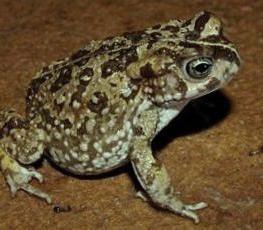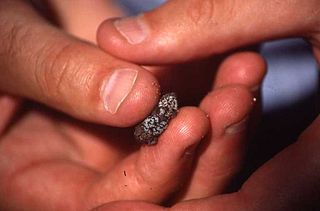
The North American green toad, Anaxyrus debilis, also known by its old name Bufo debilis, is a species of toad found in the southwestern United States in the states of Arizona, New Mexico, Colorado, Kansas, and Texas, as well as in northern Mexico in the states of Tamaulipas, San Luis Potosí, Durango, and Zacatecas. It is commonly called green toad.

The sand toad, Cape sand toad, common Cape toad, or narrow-headed toad is a species of toad in the family Bufonidae. It is endemic to South Africa and found in southwestern and southern part of Western Cape Province to extreme southwestern Eastern Cape Province, from Nieuwoudtville in the west to Humansdorp in the east, along the coastal flats and Cape Fold Mountains from the sea level to 1,500 m (4,900 ft) asl.

Duttaphrynus atukoralei is a species of toad in the family Bufonidae. It is endemic to Sri Lanka where it is found on the coastal lowlands of southern half of Sri Lanka below 200 m (660 ft) asl.
The Beira toad, or Beira pygmy toad, is a species of toad in the family Bufonidae from southern Africa.
Poyntonophrynus damaranus is a species of toad in the family Bufonidae. This species was previously known as Bufo damaranus, which is now considered a synonym. This anuran is endemic to Kaokoveld-Waterberg in area of northern and northwestern Namibia. The validity of this species has been questioned.
Poyntonophrynus grandisonae is a species of toad in the family Bufonidae. It is endemic to Namibe Province, Angola. Its range may be more widespread than currently known, including the nearby Iona National Park. It is only known from a few specimens because there has not been much research in the surrounding area, and thus its 2014 IUCN Red List of Threatened Species assessment remained at "Data Deficient".
Poyntonophrynus hoeschi is a species of toad in the family Bufonidae. It is endemic to western and central Namibia. The specific name hoeschi honours Walter Hoesch, a German zoologist. Common names Hoesch's toad, Hoesch's pygmy toad, and Okahandja toad have been proposed for it.
Poyntonophrynus kavangensis is a species of toad in the family Bufonidae. It is found in Angola, Botswana, Namibia, Zimbabwe, and presumably Zambia. Its natural habitats are sandy areas of grasslands. It is associated with ephemeral pools and pans. It can breed in hypersaline pans.
Mertensophryne lindneri is a species of toad in the family Bufonidae. It is found on the coastal lowlands of eastern Tanzania and northern Mozambique to southeastern Malawi, up to 650 m (2,130 ft) asl. Its habitats are woodlands, thickets, dry forests, farmland, and even rocky outcrops; it tolerates low-intensity cultivation. Its breeding habitat is unknown but presumably includes ponds or streams. It is considered uncommon but also difficult to observe, typically found after heavy rain. The intensification of agriculture and expanding human settlements are considered likely threats to it.
Poyntonophrynus lughensis is a species of toad in the family Bufonidae. It is found in Somalia, northern and eastern Kenya, eastern, central and southern Ethiopia, and extreme southeastern South Sudan. Its natural habitat is very dry savanna. It breeds after the beginning of the rains in temporarily flooded hollows, including roadside ditches. The main threat to this species environmental degradation caused by human expansion and settlement, with increased populations of livestock as a consequence.
Poyntonophrynus parkeri is a species of toad in the family Bufonidae. It is found in central Tanzania and in southwestern Kenya, from the Usangu Plain in the south northward to the southern Great Rift Valley, Kenya. It is a poorly known species, however, and its distribution might be broader.

Sclerophrys perreti is a species of toad in the family Bufonidae. It is endemic to the Idanre Hills in southwestern Nigeria. Sclerophrys perreti is one of the frogs declared as "Lost" in 2010. However, it was re-discovered at its type locality in 2013. Before that, it had not been seen—possibly—since 1970, and with certainty, since 1963. Common name Perret's toad has been coined for it.
Mertensophryne taitana is a species of toad in the family Bufonidae. It is found in southeastern Kenya and southward through Tanzania to southeastern Democratic Republic of the Congo, northern Zambia, Malawi, and adjacent Mozambique. Its natural habitats are sandy places in woodlands, grasslands, open savanna, and agricultural fields. It is an opportunistic breeder utilizing small, temporary pools, and apparently, streams. The tadpole develop very fast, reaching metamorphosis in only 13 days. This adaptable species is not believed to face any significant threats.
Sclerophrys urunguensis is a species of toad in the family Bufonidae. It is found in the border area of Tanzania and Zambia, near the southeastern corner of Lake Tanganyika. One recent Tanzanian record is from close to the border with Burundi. Morphological characters suggests that it actually belongs to the genus Poyntonophrynus, but the formal move to that genus has not been made. Common name Urungu toad has been coined for it.

Poyntonophrynus vertebralis is a species of toad in the family Bufonidae. It is found in South Africa, Lesotho, and possibly Botswana and southeastern Zimbabwe. It has many common names: pigmy toad, pygmy toad, flat toad, African dwarf toad, and southern pygmy toad.

Mertensophryne is a genus of true toads. They are found in eastern and southern Democratic Republic of Congo to Kenya, Tanzania, Malawi, southeastern Zimbabwe, and adjacent Mozambique. Their common names include snouted frogs, Chirinda forest toads, and forest toads. The genus is named for Robert Mertens, German zoologist and herpetologist.
Osgood's Ethiopian toad is a possibly extinct species of toad in the family Bufonidae endemic to the mountains of south-central Ethiopia. It was named for the American biologist Wilfred Hudson Osgood who carried out fieldwork in Ethiopia for the Field Museum in 1926–27. He collected the original specimens of Osgood's Ethiopian toad and three other endemic species of anuran.
The Chirinda toad, Chrinda forest toad, Mashonaland toad or Boulenger's earless toad is a species of toad in the family Bufonidae with a restricted distribution in eastern Zimbabwe and western Mozambique.
The Mahenge toad or Loveridge's forest toad, Mertensophryne loveridgei, is a species of toad in the family Bufonidae. It is endemic to Tanzania; its common name refers to the Mahenge Plateau where it can be found. Its natural habitats are tropical forests and woodlands. It is not considered threatened by the IUCN.

Poyntonophrynus fenoulheti is a species of small toad found in southern Africa. It is known under many common names, including Fenoulhet's toad, Fenoulhet's pygmy toad, and northern pygmy toad. It grows to a maximum size of 43 mm.







